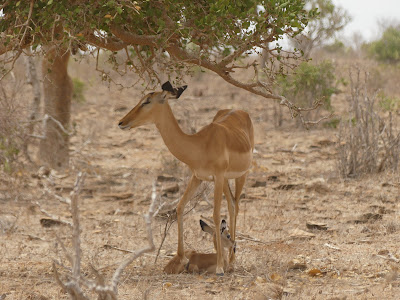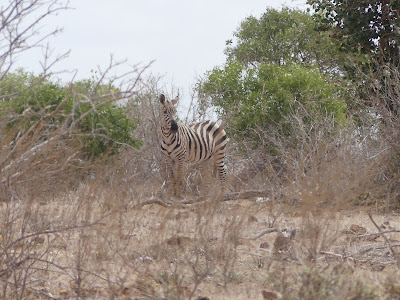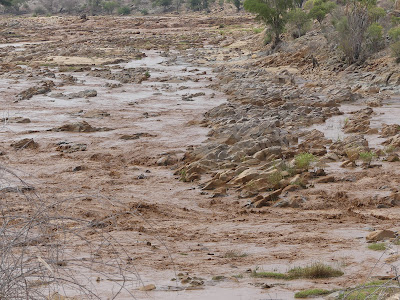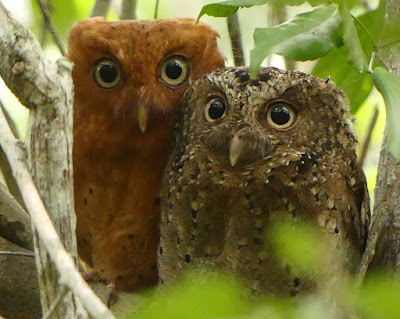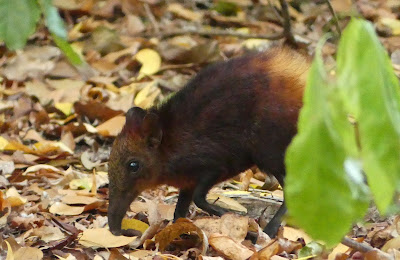There was only a very brief overnight stay in Nairobi before
heading east to Watamu on the coast, adjacent to the Indian Ocean. It's been a week of ups and downs. It was a
long drive, over 8 hours, hampered by the clapped out HGVs that trundle along
the road between Nairobi and Mombasa. These fume belching hulks are sent over
from other non-European countries, once their working lifespan has expired.
They are extremely polluting and very slow.
Much of the road has a solid yellow central line, indicating
that overtaking is not allowed. It is completely ignored by all, not being a
matter of safety. Otherwise it would take much longer to get anywhere. Even the
lorries overtake on it when able. So, that was how we became the victims of
the Kenyan Police. We crossed the line, were seen and were also white. There
are no on the spot fines in Kenya, but we were given the option to pay 15,000
Shillings to avoid appearing at court in 3 day’s time. The court was close to
where the offence occurred and we still had a long way to drive.
We began negotiating, making a fuss as we didn’t have enough
money on us and eventually got it down to 4,000 Shillings, ‘One note for each
of you’ as Chris said, equivalent to about £35.00 and around £900 each. You can buy a great deal
with that in Kenya.
We finally made it to A Rocha, Kenya where we were staying
and food had been saved for us. We hadn’t eaten since breakfast so were quite
hungry.
The area is known for the marine reserve and its coral reef, and the white sand and fossilised coral rocks are beautiful against the azure sea.
Our plan was to go birding, some independent and some with
guides. On the first day we looked around the little nature reserve where most
of the scientific works takes place, notably bird ringing and moth catching. It
was already very hot by 7:30am but we continued on to walk through the coastal
scrub. We saw a few different birds but noticed a Mangrove Kingfisher with a
data logging backpack. Much of the rest of the day was spent in the shade – it
was just too, too hot. There had been no rain there since May. When we
mentioned the backpack it was at first thought to be a juvenile that had been processed
the week before, but as it was an adult it had been wearing the equipment some
time. There were efforts to catch it but no luck unfortunately.
Mangrove Kingfisher
I will not include a full list of sightings but just add
some highlights.
A grab and smash episode with a Syke’s Money at breakfast
was exciting. It didn’t get much but knocked plates flying in its effort to
escape. This bold behaviour was also the reason for a locking hook on the
fridge.
Food thief - Syke's Monkey
A personal favourite from a day with Willy the guide was
Sokoke Scops Owl. Discovered in the forest reserve in 1965. They were caught in
mist nets, in use for a bat survey, and had not been known of before. They are
endemic to the 402KM square reserve and to this day a nest has never been
found.
Sokoke Scops owls, male and female
The Golden-rumped Elephant Shrew were also fascinating to see, more like a miniature Tapir than a shrew.
Unfortunately we picked up a puncture in the forest and a
flat tyre next morning meant that we didn’t make it to the high tide wader
count at Mida Creek. After getting help at the lodge the tyre was removed for repair, but because the spare had been chained under the car to prevent theft, we lost most of the morning. So glad not to have been on the side of the road trying to find someone with a hacksaw to release the spare! Crab Plovers were the star attraction when we eventually got there, accompanied by
a nice mix of other waders. The Mangroves were also interesting to see as was
the rickety board walk with the planks of different sizes, and spacing, some
missing altogether and the peculiar single rope on either side that differed in
height depending on which section you were crossing.
Boardwalk at Mida Creek
There was a lake that we went to look across, but some much
needed rain made the tracks slippery, and the dry tracks around the shrunken
pool, swelled by the rains were submerged. We didn’t get too close but Chris
managed to find some ducks and waders.
African Wild Cat
The second guided trip was to the river mouth at Sabaki,
again lots of waders, gulls and terns. Jarou, our guide, wasn’t a patch on
Willy and he didn’t know about the birds, but was paid mainly to ensure the safety of
the vehicle and for showing us the place where we could see birds. Later he
took us to see Hippos and Flamingoes(that we’d noticed from the bridge) and there we were
very pleased to see African Wild Cat. Of course, not being as large as the
Hippos, Jarou couldn’t see it.
The other highlight was returning to the accommodation to be
called to see 3 birds disappearing into the distance. They turned out to be
three Lesser Frigate birds only 3 or 4 previous records.
Record shot Lesser Frigate Bird.
On 18th November we were all packed up, including equipment for the ringing camp, and left for Ngulia.




